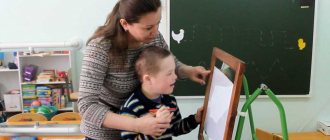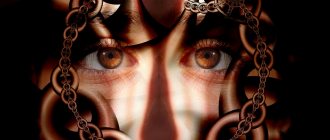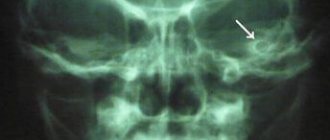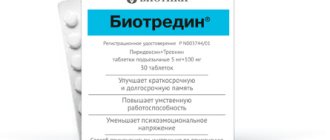Convulsive syndrome
There are two types: non-epileptic and epileptic. Seizures of a non-epileptic nature can develop into epileptic seizures, which primarily affect newborns and young children. Often, convulsions are preceded by asphyxia of newborns, intracranial birth or domestic trauma, hypocalcemia, hypoglycemia, hemolytic disease of the newborn, as well as intrauterine infections. Convulsive syndrome occurs during acute infectious diseases, in case of intoxication and poisoning (with uremia, hepatic coma, toxic syndrome, household poisoning), with phenylketonuria and other abnormalities of amino acid metabolism, galactosemia.
Causes of seizures
Seizures occur due to congenital defects in the development of the central nervous system, hereditary metabolic diseases, abscesses and tumors. They also appear in cases of blood diseases such as hemophilia, thrombocytopenic purpura, and in cases of disruption of the cardiovascular system, for example, congenital heart defects, collapse. Convulsions and fainting may occur as a result of increased emotionality. In young children, convulsive syndrome may occur due to high fever. Feverish convulsions can turn into epileptic seizures with traumatic brain injury.
Convulsive syndromes include paroxysmally occurring and, as a rule, equally suddenly ending conditions with convulsive phenomena, accompanied in most cases by stupefaction. The manifestation of the convulsive syndrome is extremely varied: from a large full-blown convulsive seizure to rudimentary retropulsive seizures, characterized by nystagmus-like twitching of the eyeballs and myoclonic spasms of the eyelids. A thorough examination of each type of convulsive syndrome is often decisive for the diagnosis of many organic diseases.
Epileptic grand mal seizure.
There are several phases in the development of a grand mal seizure.
A seizure is often preceded by an aura, but it does not belong to the phases of a convulsive seizure (see chapter Epilepsy).
The tonic phase begins with a sudden, lightning-fast loss of consciousness and a sharp tonic convulsion, during which the patient falls as if knocked down with a distorted grimace, and the fall occurs most often on his face, less often on his back or to the side. During a fall, the patient emits a kind of sharp cry associated with a spasm of the muscles of the glottis. After the fall, the patient continues to be in a state of tonic convulsion, and due to increased muscle tone, the head is thrown back, the arms are bent at the elbows, pressed to the chest, the hands are bent, the fingers are clenched into a fist, the lower limbs are bent at the knees and hip joints and pressed to the stomach or separated to the sides and bent at the knee joints. Sometimes during the tonic phase a different position of the limbs is observed: the arms are extended forward, the spine bends back in retroflexion, the hands take the shape of an “obstetrician’s hand.” In certain positions of the limbs, there is a risk of fractures: for example, a sharp extension towards the lower limbs can lead to a fracture of the femoral neck, retroflexion of the spine can lead to a fracture of the lumbar or thoracic vertebrae, etc. Usually there is a bite of the tongue and a bite of the inner surface of the cheek. Sometimes, with convulsive clenching of the jaws, traumatic amputation of the tip of the tongue can occur, especially if the tonic phase began during a conversation or if the tongue was protruding at the time of its development. Due to a tonic spasm of the respiratory muscles, muscles of the chest, abdominals and diaphragm, breathing stops and, following the initial pallor of the skin, a sharp cyanosis develops; Cardiac activity stops for a short time. During the tonic phase, due to a sharp tonic contraction of the sphincter muscles, involuntary urination and defecation never occur; at the same time, men often experience erection and even ejaculation of semen due to tonic contraction of the corresponding muscles. Total areflexia is observed. The loss of consciousness is very pronounced; even the strongest and most intense stimuli do not cause a response (coma). This explains the severe injuries, burns, and injuries suffered by patients during a seizure. The duration of the tonic phase is up to 20-30 s.
The clonic phase follows the tonic phase. Rhythmic and symmetrical twitching begins in the eyelids and distal phalanges of the fingers. Increasing in intensity, the spasms spread to the muscles of the limbs, torso, neck, and head. After such generalization, the convulsions subside.
The amplitude of flexion-extension movements of the upper limbs during such convulsions is quite large, while the lower ones are more limited. The head turns rhythmically to the side, the eyes rotate, the tongue periodically protrudes, the lower jaw makes chewing movements, and various grimaces appear on the face associated with a clonic spasm of the masticatory muscles. During the clonic phase, patients experience involuntary urination, defecation, as well as increased sweating, hypersecretion of saliva and discharge from the bronchial mucosa. The foamy liquid released from the mouth of patients is a mixture of saliva accumulated and collected in the oral cavity with secretions from the bronchi, blood from biting the tongue or the mucous membrane of the cheek. By the end of the clonic phase, which lasts from 1 to 3 minutes, the frequency and amplitude of clonic twitches are reduced, breathing begins to recover, and cyanosis decreases. However, even after completion of the clonic phase, patients may experience a slight increase in muscle tone and breath holding, which is determined by biochemical changes during the seizure.
Phase of darkened consciousness (coming out of coma). In some cases, a comatose state with areflexia, a sharp relaxation of muscles and sweating, as well as respiratory failure is replaced by a state of deep stupor, which in turn, through a state of obscurity, passes into clear consciousness or sleep; in others, the stupor, which was preceded by a coma, is transformed into a twilight disorder of consciousness with pronounced epileptiform excitation, which can be more or less prolonged, and in some cases lasts up to several days. Following complete recovery from a seizure, some patients experience a feeling of relief, sometimes accompanied by some euphoria, while others, on the contrary, experience a feeling of weakness and increased physical and mental fatigue. A low mood with a hint of irritability, a feeling of extreme displeasure, and sometimes anger may be observed.
Epileptic state ( status
epilepticus )
. This is a series of grand mal seizures following one after another. The frequency of seizures is often so high that patients do not come to their senses and are in a comatose, stuporous or stunned state for a long time. The epileptic state can last from several hours to several days. During an epileptic state, a rise in temperature, increased heart rate, a drop in blood pressure, sudden sweating, weakness of cardiovascular activity, pulmonary and cerebral edema are often observed. The content of urea in the blood serum and protein in the urine increases. The appearance of these disorders is a prognostically unfavorable sign.
Adverse convulsive seizure.
Like a classic epileptic seizure, an aggressive seizure begins with a tonic phase, but in this case it develops more slowly and is usually not preceded by an aura. The rotation of the body around the longitudinal axis is peculiar: first there is a violent rotation of the eyeballs, then the head and the entire body turn in the same direction, the patient falls. The clonic phase begins, which is no different from that of a grand mal seizure. The development of an aggressive seizure is associated with organic damage to the frontal lobes of the brain, and with the left-sided localization of the process, a slower fall of the patient is observed than with the right-sided one.
Partial seizure (Bravais-Jackson seizure).
With such a seizure, the tonic and clonic phases are characterized by convulsions of a certain muscle group, and only in some cases does generalization of the seizure occur. Partial seizures can manifest themselves as muscle spasms of only the upper or lower limb, or facial muscles. The dynamics of cramps in the limbs always has a proximal direction. So, if a seizure develops in the muscles of the arms, a tonic spasm moves from the hand to the forearm and shoulder, the arm rises and a forced turn of the head occurs towards the raised arm. Next, the clonic phase of the seizure unfolds. If the seizure begins with leg muscle spasms, tonic spasms appear in the foot muscles, with plantar flexion occurring, then the spasms spread upward to the lower leg and thigh, sometimes covering the body muscles on the corresponding side. And finally, if the seizure is localized on the face, the mouth becomes distorted in a tonic spasm, then the latter spreads to the entire facial muscles on the corresponding side. Generalization of Bravais-Jackson seizures is possible: in these cases they are extremely reminiscent of a normal convulsive seizure; their only difference is that there is a predominance of the intensity of convulsive phenomena on one side of the body. Generalization of partial seizures is most often accompanied by loss of consciousness. Bravais-Jackson seizures often occur in series and can end in flaccid paralysis, usually when the organic process is localized in the anterior central gyrus.
Tonic postural seizures.
Such seizures begin with a powerful tonic convulsion, as a result of which opisthotonus occurs, breath holding with symptoms of cyanosis and the patient loses consciousness; this usually ends the attack. There is no clonic phase in this type of seizure. Tonic postural seizures develop when the brainstem is damaged.
NONCONVULSIVE (MINOR) SEIZURES
Minor seizures, unlike major ones, are short-lived and their clinical manifestations are extremely varied.
Absence.
These are short-term “turn-offs” of consciousness (for 1-2 s). After the absence seizure ends, sometimes immediately, the patient’s normal activities are resumed. At the moment of “turning off” consciousness, the patient’s face turns pale and takes on an absent expression. There are no seizures. The attacks can be single or occur in a series.
Propulsive seizures.
Despite the variety of states attributed to these seizures, they are characterized by an indispensable component of a jerky forward movement - propulsion. They occur between the ages of 1 and 4-5 years, usually in boys, mainly at night, without visible provoking factors. In later life, grand mal seizures often appear along with propulsive seizures.
Salam-fits.
The name reflects the peculiarity of these seizures, which outwardly resemble the movements made during an ordinary eastern greeting. The seizure begins with a tonic contraction of the trunk muscles, as a result of which the body bends over, the head droops, and the arms are extended forward. The patient usually does not fall.
Lightning seizures
differ from salam seizures only in the faster pace of their development. Their clinical picture is identical. However, due to the lightning-fast development of tonic convulsions and a sharp forward movement of the body, patients often fall prone.
Clonic propulsive seizures
are characterized by clonic convulsions with a sharp forward movement, and the propulsive movement is especially intense in the upper part of the body, as a result of which the patient falls on his face.
Retropulsive seizures.
Despite the variety of conditions attributed to them, these seizures are characterized by an indispensable component of a jerky backward movement - retropulsion. Occurs between the ages of 4 and 12 years, but more often at 6-8 years (later propulsive), usually in girls, mainly in a state of awakening. Often provoked by hyperventilation and active tension. Never happens during sleep.
Clonic retropulsive seizures
are
small clonic convulsions of the muscles of the eyelids, eyes (lifting up), head (throwing back), arms (leaning back). The patient seems to want to reach something behind him. As a rule, a fall does not occur. There is no reaction of the pupils to light, sweating and drooling are noted.
Vestigial retropulsive seizures
They differ from clonic retropulsive seizures in that they do not unfold: only some protrusion and small nystagmoid twitching of the eyeballs occur, as well as myoclonic convulsions of the eyelids.
Pycnolepsy
is
a series of retropulsive clonic or rudimentary retropulsive clonic seizures.
Impulsive seizures
characterized by a sudden, lightning-fast, impetuous throwing of the arms forward, spreading them to the sides or bringing them closer together, followed by a jerky movement of the body forward. The patient may fall backward. After a fall, the patient usually gets back to his feet immediately. Seizures can occur at different ages, but are most common between 14 and 18 years of age. Provoking factors: insufficient sleep, abrupt awakening, alcoholic excesses. Impulsive seizures occur, as a rule, in series, following directly one after another or at intervals of several hours.
Diagnosis of seizures
During seizures, changes can be detected on the EEG. Also, radiography of the skull shows the small size of the fontanelles or their early closure, the presence of digital impressions, increased size of the skull with hydrocephalus, intracranial hypertension, changes in the contours of the sella turcica and foci of calcification. Rheoencephalography can detect asymmetry of blood supply to the brain and changes in its blood flow and blood supply. It is possible to use pneumoencephalography, angiography, echoencephalography and other studies.
The cerebrospinal fluid is also examined, and an increase in pressure to 140 mmH2O is detected. Art., an admixture of blood in the cerebrospinal fluid, the number of cells and protein increases. A biochemical blood test can detect hypocalcemia, hypoglycemia, rickets, and alkalosis, which are the causes of seizures.
Symptoms of seizures
The clinic of convulsive syndrome is expressed in the form of clonic-tonic involuntary short-term contractions of skeletal muscles, which are local or generalized in nature. Convulsions are characterized by an acute onset, agitation, and changes in consciousness. If the attacks are repeated, and consciousness does not return in the interval between them, then this indicates a convulsive status.
The diagnosis is based on the medical history and clinical manifestations.
Differential diagnosis is based on determining the cause of seizures.
Information for friends and family
Pass this information on to your family and friends so they know what to do if you have a seizure.
What should I do if someone I care about has a seizure?
- Keep calm.
- Keep the person away from anything that could be dangerous, such as sharp objects.
- Turn the person onto their side.
- Place something soft under your head and loosen tight clothing.
- If you can, notice how long the seizure lasts.
- Note how the seizure progresses so you can describe it to the health care provider or emergency personnel.
- Stay close until the seizure is over.
- Report the incident to the person's healthcare provider.
What should you not do during a seizure?
- Do not try to stop the seizure or use restraining measures, such as holding the person down.
- Don't put anything in a person's mouth.
- Do not give the person anything to eat or drink until he or she is awake and fully alert.
Treatment of seizures
First, it is necessary to eliminate the cause of the seizures - for febrile seizures, antipyretics are prescribed, and in case of hypocalcemia, a calcium gluconate solution is prescribed. Hypoxia, respiratory and heart failure are eliminated, and detoxification is carried out. Anticonvulsants include seduxen solution and hexenal solution.
A spinal puncture is performed according to indications, 10 ml of fluid is removed, resulting in a decrease in intracranial pressure. Luminal or other anticonvulsants are also prescribed, which are administered every 3 hours.









